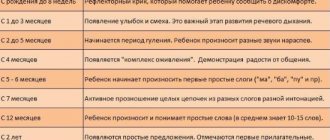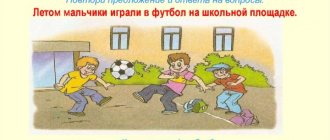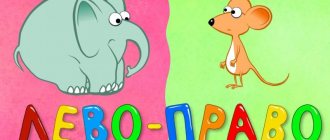Critical periods of speech development
Maria Checheleva
Critical periods of speech development
Critical periods in the development of speech function
Speech function is one of the most important mental functions of a person.
In the process of speech development, higher forms of cognitive activity and the ability to conceptual thinking are formed. The meaning of a word in itself is a generalization and, in connection with this, represents not only a unit of speech, but also a unit of thinking. They are not identical and arise to some extent independently of each other. But in the process of the child’s mental development , a complex, qualitatively new unity arises - verbal thinking , speech-thinking activity .
Mastering the ability to verbally creates the prerequisites for specifically human social contacts, thanks to which the child’s ideas about the surrounding reality are formed and refined, and the forms of its reflection are improved.
A child’s mastery of speech contributes to awareness, planning and regulation of his behavior. Speech communication creates the necessary conditions for the development of various forms of activity and participation in collective work.
Speech disorders to varying degrees (depending on the nature of speech disorders )
negatively affect the entire mental development
affecting his activities and behavior. Severe speech impairments can affect mental development , especially the formation of higher levels of cognitive activity, which is due to the close relationship between speech and thinking and the limited social, in particular speech , contacts, during which the child learns about the surrounding reality.
Speech disorders and limited verbal communication can negatively affect the formation of a child’s personality, cause mental layers, specific features of the emotional-volitional sphere, and contribute to the development of negative character traits (shyness, indecisiveness, isolation, negativism, feelings of inferiority).
All this negatively affects literacy, academic performance in general, and choice of profession.
There are three critical periods in the development of speech :
1 period
occurs in the first two years of a child’s life, when the prerequisites for speech appear and its active formation begins. the cortical speech zones develop most intensively , in particular Broca's area, the critical period which occurs at the age of 14-18 months. Even minor unfavorable factors operating during this period can affect speech development .
2 critical period-
three year old child. At this stage of development , significant changes occur: coherent speech develops , the transition from situational to contextual speech begins, which requires great consistency in the work of the central nervous system with peripheral speech mechanisms and other functions. However, due to their immaturity, some discrepancy may arise in the functioning of the nervous system, endocrine, and vascular systems, which leads to changes in the child’s behavior, manifested in negativism, stubbornness and determines the vulnerability of the speech system . For these reasons stuttering may develop speech development may be delayed . Stuttering can also arise due to age-related unevenness in the maturation of individual parts of the speech functional system and other mental functions.
3 critical period –
age 6-7 years. Associated with the child’s preparation for school and the beginning of education there. Its main feature is that the load on the central nervous system increases. If increased demands are placed on the child at this time, then a kind of disruption of nervous activity occurs, which can cause stuttering.
The named critical periods are predisposing conditions for the occurrence of speech disorders . They can have either independent significance or be combined with other unfavorable factors: genetic, general weakness of the child, dysfunction of the nervous system, etc.
Stages of children's speech development
Knowing the main stages of speech development will help to identify possible speech problems in a child in a timely manner. Despite the fact that there are no strict standards (after all, each child develops at his own individual pace), any deviation from age norms should alert attentive parents and become a signal for timely contact with a speech therapist. It is better to have a specialist refute your concerns than to miss a grace period to correct the violation.
The first year of life is extremely important for a child’s speech development, as the speech areas of the brain are actively maturing. The first year is the pre-speech period, which is the foundation for the further development of speech. It can be conditionally divided into the following stages: first (0 – 3 months) – development of emotional and expressive reactions; the second (3 – 6 months) – the time of appearance of vocal reactions (humming and babbling); third (6 – 10 months) – the beginning of the development of speech understanding and active babbling; fourth (10 months – 1 year) – the time of the appearance of the first words.
First stage (0 – 3 months)
Screaming is the first vocal reaction. The cry of a healthy child is loud and long. By 2–3 months of life, intonations when screaming become varied. For example, the cry of a hungry baby is shrill and persistent, but the cry of discomfort is sluggish and inexpressive. A “revitalization complex” appears - the simplest form of pre-verbal communication with an adult in the form of a smile, general chaotic movements, sounds, and following an adult with one’s gaze. Already at this age it is possible to intensify the child’s development, because With the advent of the revival complex, the child begins to need constant communication. It is necessary to offer the child toys of different shapes and colors, loud sounds, play with him more often, moving toys, cultivating visual concentration and motor grasping actions.
By the way, in order to calm the baby, it is not necessary to resort only to the pacifier, because when he sucks on it, he is completely distracted from the world around him.
Second stage (3 – 6 months)
By the third month or a little earlier, humming appears. Humming – long, quiet melodious sounds: “a-a-a-a”, “gu-u-u”, “a-bm”, “boo”, etc. These sounds are either easy to pronounce or associated with the acts of sucking and swallowing. During the period of rejoicing, an intonation of joy appears. The baby walks when he feels good: he has slept, is dry and well-fed. At 4 months, sound combinations become more complex and new ones appear: “gn-agn”, “rn”, “khn”, etc.
Absolutely all children have babbling. Children all over the world walk the same way: in the speech of the baby you can hear the sounds of all languages. But later the baby will select only those sounds that are characteristic of his native language.
With normal development of a child at 4–5 months, humming smoothly turns into babbling. Babbling is the reproduction of syllable combinations, imitation of the speech of others. The most intensive process of accumulation of babbling sounds occurs after the sixth month. With severe speech disorders, babbling is detected in children at a later age! For the deaf and hard of hearing, the humming fades out. During this period, the mother should happily repeat individual syllables and words after the child, voicing them correctly, helping to find objects corresponding to these words.
Third stage (6 – 10 months)
From 7–8 months to 1 year, few new sounds appear. The child rhythmically repeats “cha-cha-cha...”, “gee-ha-gee...” and other babbling chains many times in a row, honing his pronunciation skills and at the same time listening to himself. So gradually quantity turns into quality. Babbling words appear, which the baby associates with certain persons, objects, and actions. “Bi-bi” - points to the car, “top” - walks, “ma-ma” - addresses mom, etc. Babbling words consist of those sounds that are close in sound to the sounds of the native language (as opposed to the sounds of humming). Healthy children have emotionally expressive speech. In the process of communicating with adults, the child tries to imitate the intonation, tempo, rhythm of spoken speech, and maintain the general contour of the word.
During this period, an understanding of the speech of others is formed. Already at 7–8 months, children begin to respond adequately to words and phrases that are accompanied by gestures and facial expressions. The child turns his head in response to the questions “Where is daddy?” Woman?". Reacts to his name. Knows the usual location of household items (clocks, cribs...) if they have been shown and named before. In other words, the relationship between the sound image of the word and the object begins to develop. Complete misunderstanding of the addressed speech is an alarming signal!
Fourth stage (10 months – 1 year)
The first words appear - word-sentences. The same word can express feelings, desires and designate an object. “Mom” is an appeal, a request, and a complaint. The first words consist of paired identical (much more often) and unequal syllables: “pa-pa”, “di-di”, “bi-ka”, etc. In this case, one syllable is distinguished by its volume and duration. This is how the emphasis is laid. Speech activity at this age is situational and depends on the adult’s emotional participation in communication. At 1 year old, a healthy baby speaks 8-10 words like “kiss-kiss”, “mu”, “yum-yum”.
From 1 year to 3 years (pre-school age), active speech develops as the child begins to walk. With the advent of the ability to move, ideas about the surrounding world quickly expand, speech develops intensively: the baby asks what is called what. In speech, sound distortions are observed, stressed and initial syllables are used, difficult sounds are skipped, and there are permutations of syllables.
By the end of the second year of life, elementary phrasal speech . When communicating with an adult, the baby combines 2-3 words, for example, “give pi” (give me something to drink), “papa bi” (dad left), etc. Gradually, grammatical categories are formed (number, gender, case...).
By the age of 3, the child independently uses the simplest grammatical structures . When communicating with adults or peers, children use simple sentences.
Characteristic of this period is a fairly stable reproduction of the intonation-rhythmic contours of words, for example, “kayable” - ship, “petenka” - cookie, “badyadya” - lipstick.
word creation appears . The child comes up with his own words, but at the same time uses the laws of his native language: “palchatki” - gloves, “kopatka” - spatula, i.e. the baby masters the basic laws of language.
In subsequent years, the child actively increases both the passive vocabulary (speech understanding develops) and the active vocabulary (this is the vocabulary that the child uses in speech). Normally, by the age of 5, he should have developed all aspects of his native speech : vocabulary, grammar, sound pronunciation and phonemic perception. The child must have a fairly rich vocabulary, be able to coherently talk about some event in life or retell a fairy tale, story, and do it competently, observing the agreement of words in phrases, word endings, etc. Free speech of five-year-old children, whether retelling what they heard or a story invented by oneself or reflections on something important for the child, includes complex sentences with correctly constructed cause-and-effect relationships. “They gave me a guinea pig because I really wanted my own pet. She will not be able to feed herself, so she needs to be looked after. She squeals loudly when we come home because she is so happy.”
Adults make a significant contribution to the development of speech in children from 3 to 5 years old and their communication skills if they competently, interestedly and, most importantly, constantly communicate with the child, comment and clearly articulate their and his actions, encourage him to tell stories, explain various situations and phenomena.
Patterns of normal speech development according to A. N. Gvozdev
The proposed scheme is based on the peculiarities of the appearance of parts of speech and grammatical categories in children. A. N. Gvozdev distinguishes two stages:
- use of amorphous words;
- mastery of grammatical categories.
When constructing correctional work, speech therapists rely on these patterns of ontogenetic speech development.
Amorphous root words
A. N. Gvozdev begins to consider the acquisition of the native language system from one year and 8 months, when the baby already has his first words. This stage is divided into two sub-periods, each of which has its own characteristics.
- One-word - the baby uses only individual words that act as sentences. Some of them serve to express his desires and feelings. At this time, he actively uses facial expressions and gestures. The first words do not have a clear grammatical form: he uses them in one sound image in different contexts (“bi” - car, driving, etc.).
Most of them are nouns, onomatopoeic complexes and babble. In total, the child’s dictionary during this period contains about 29 such amorphous words. He clearly pronounces vowels, labiolabials, front-lingual, back-lingual, Сь, Ль. The syllabic structure consists of one stressed syllable or two identical ones.
- The second sub-period is characterized by combining words into one phrase, but it is ungrammatical. Indeclinable nouns and verbs appear in the form of the imperative mood (“drink”, “give”, etc.). The syllable structure becomes more complex: the baby learns the pronunciation of two-syllable words. Хь, Ц, И appears, sometimes he may omit a sound at the beginning or end of a word. The baby also masters the pronunciation of consonant clusters that appear in the middle of some words.
During this age period, the prerequisites for the child’s successful mastery of the components of the language system are formed. He begins to use the simplest forms of parts of speech and sounds with simple articulation patterns.
Mastering the grammatical structure of sentences
This long period begins at 1 year 8 months. and lasts up to 6 years. The child masters all grammatical skills; The syllable structure and sound pronunciation are fully formed by the age of 5-6 years. Children are actively engaged in word creation. This phenomenon is caused by attempts to master the norms of the native language without knowing the grammatical rules.
First period
First forms of words (1 year 8 months – 2 years). The baby combines 3-4 words into a sentence. He masters the skill of agreeing a noun in the nominative case with a verb, and the initial signs of adjective subordination appear. Phrase speech itself is characterized by ungrammaticality.
Begins to decline words according to cases (nominative, accusative, prepositional); adds diminutive suffixes; new inflections of verbs appear; often omits prefixes.
During this period, the first adjectives appear, but the child uses them without agreement with the noun. Adverbs and pronouns appear (he speaks about himself in the 3rd person); particles. In three-syllable words the child omits the pre-stressed syllable, but in four-syllable words the syllable structure is most often preserved.
Articulatory structures N, T, D appear. Most of the consonant clusters are replaced by a single phoneme.
Second period
From 2 years to 2 years 6 months. endings are learned and conjunctions are added to sentences. A common mistake is replacing endings and using them within the same meaning. Suffixes, dative and instrumental cases appear. Begins to inflect verbs according to persons and tenses, but can mix gender.
The number of adjectives increases, but when using them, the child violates the norms of agreement. The plural form is used only in the nominative case. Personal pronouns are being learned; adverbs that are used for comparison. More prepositions and complex conjunctions appear.
In complex words, omission of pre-stressed syllables and prefixes is most common. The child often mixes similar phonemes in speech. The sequence of consonants remains unlearned, but he pronounces some groups correctly.
Third period
From 2.6 months By the age of 3 years, the child masters the functional parts of speech. The structure of the sentence becomes more complex, and the skill of subordinating words appears. But the child has not yet mastered the category of gender. Almost all the main case endings have been mastered, but the influence of O is more common in them. Suffixes denoting increase are being mastered.
The child freely uses all forms of reflexive verbs and prefixes. But sometimes he can mix them up. Begins to use coordination skills when constructing sentences. Forms of short participles appear. The child confuses possessive pronouns. Uses prepositions and most conjunctions correctly.
Distortion of syllable structure is rare, most often in unfamiliar words. Articulatory patterns of hissing sounds are formed; the pronunciation of consonant sequences is learned.
The fourth period
At 3-4 years old, agrammatic sentences become less and less common in children’s speech. The child is actively engaged in word creation. The ending -OV continues to influence the declination. Difficulties arise in agreeing neuter adjectives. The comparative degree of adjectives and adverbs, the particle BY, appears. The pronunciation side is fully formed.
Fifth period
The period from 4 to 6 years is characterized by the acquisition of almost all grammatical forms of parts of speech. The child has difficulty making sentences with the word “which”.
The boundaries of all the listed stages are approximate; everything depends on the individual characteristics of the child, on the conditions of the speech environment in which he grows. Thanks to knowledge of the stages of ontogenetic development of speech, it is possible to determine how the process of assimilation of language components proceeds. Taking into account ontogenetic and mental characteristics, speech therapists carry out correctional work.
Preschool stage
The preschool period is characterized by the most intensive language development of children. This is a qualitative leap in vocabulary expansion. The child begins to actively use all parts of speech, and the skills of constructing words are gradually formed. The process of language acquisition is so dynamic that children with a good level of language development from the age of 3 not only communicate fluently using grammatically correct simple sentences, but also use many types of complex sentences, conjunctions and related words:
- I'll draw it in green because she's always sick;
- I will have long hair around my ears because it is my temptation;
- We will all turn into icicles when the evil and angry wind blows.
At this time, a more complex use of words occurs in accordance with their meanings, and word formation processes are improved. At the age of five or six years, children's statements are quite long, and a certain logic of presentation is captured in them.
In preschool age, there is a gradual separation of language and direct practical experience. The child is already able to perceive language outside the situation; now there is a need to convey to an adult the impressions received outside of contact with him, to report what he saw or retell what he heard. In accordance with this need, monologue speech begins to develop, although the preschooler’s coherent statements initially still have situational characteristics. The dialogical speech of preschoolers is improved in play activities; they use it to plan, coordinate their actions, and regulate relationships during play. By the end of the preschool period, children master the simplest forms of address orientation in choosing words and formulating thoughts. Using language in new functions requires correct phonetic, lexical and grammatical formulation.
At this time, the process of mastering phonetic articulation is completed: A normally developed child at the age of five is able to pronounce all the sounds of his native language, reproduce words of different syllabic structure and sound composition. Pronunciation errors usually occur in words that are unusual and unfamiliar to children (Rabaratorium - laboratory). Incorrect pronunciation of a word by a preschooler may be associated not so much with deficiencies in phonemic perception or difficulties in pronunciation, but with the desire to understand the form of the word in order to motivate the sound (inflatable - dandelion, web - cobweb).
The volume of a preschooler's active vocabulary grows rapidly, reaching 3.5-4 thousand words at the age of 6-7 years. Individual differences can be significant even at this age, with some children having a vocabulary of up to 12,000 words. Qualitative changes are observed in the vocabulary of children's speech: the proportion of words with a generalized meaning is increasing, words of all types are used, words are used more differentiated in accordance with their meanings, the stock of synonyms, antonyms, and ambiguous words is increasing. However, the process of developing verbal meanings at this age is not yet complete, so situations often arise when a child misunderstands a word, especially when it is used in a figurative sense, as well as incorrect use of words in the child’s speech.
Preschool children use various types of sentences in speech, including many types of complex sentences, all grammatical forms. The assimilation of the word formation system continues, and although at the beginning of this period there are still errors in the formation of word forms due to ignorance of normative variants (turnip - turnip, gun with emphasis on the last syllable - gun, clean - clean, rim - tear off, chicken - chain, tin - hard), the child gradually begins to follow the norm.
The most active process in the language of a preschool child is the process of mastering the word-formation system of the Russian language. By the age of three, only proficiency in suffixes of subjective evaluation (diminutive, affectionate, augmentative) is established; the remaining word-formation means are mastered later, and this is clearly manifested in children’s independent formation of words according to productive word-formation models - word formation: downy stupa; I don’t see where the jacket is torn; Your kisses prick; birch bends; speckled rooster; Now clowns also walk upside down?









